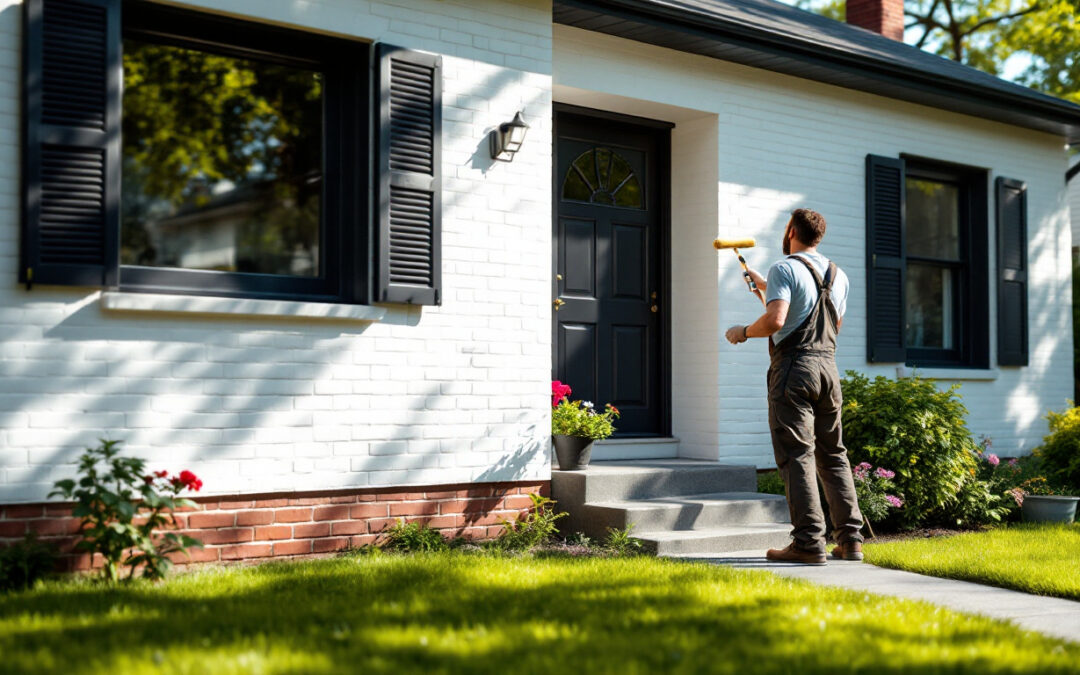Introduction
The trend of painting brick surfaces has gained significant popularity in recent years. Many homeowners are drawn to the idea of adding color and personality to their exteriors, which can elevate the overall aesthetic appeal of their properties. However, it is crucial to thoroughly understand the implications of painting over brick, as the decision involves several pros and cons that can affect both the appearance and structural integrity of your home.
Pros of Painting Over Brick
Aesthetic Appeal
One of the primary reasons homeowners choose to paint brick is for its aesthetic benefits. With a variety of colors and finishes available, painting allows you to completely transform the look of your brick surfaces. This change can greatly enhance your home’s curb appeal, making it more visually attractive to guests and potential buyers alike.
Protection from Elements
Painting brick can also serve as a protective measure against the elements. A quality paint job can weatherproof the brick, guarding it against harsh weather conditions and preventing moisture from permeating the material. This added layer of protection can be particularly beneficial in regions with high humidity or frequent rainfall, where brick is prone to damage from moisture infiltration.
Updating Old Brick
For those with dated or unattractive brick, painting can provide a quick and effective update. By choosing a modern color, homeowners can breathe new life into their property, showcasing a contemporary style that may be more appealing to today’s aesthetic preferences. Additionally, painting can mask imperfections in the brick, leading to a fresher and cleaner appearance.
Cons of Painting Over Brick
Potential Damage to Brick
Despite its benefits, painting over brick may lead to potential damage if not approached carefully. One of the main risks is that paint can trap moisture within the brick, leading to deterioration and compromising the structural integrity over time. If moisture becomes trapped, it can result in unsightly efflorescence or even severe damage requiring costly repairs.
Maintenance Challenges
Once brick has been painted, maintenance can become more complicated. Repainting can be a hassle, as it often requires specialized techniques and products to ensure adhesion and a uniform look. Additionally, you’ll need to invest in specific cleaning solutions designed to avoid damaging the painted surface, making upkeep more challenging than maintaining unpainted brick.
Reduced Breathability
Another important consideration is that painting reduces the breathability of brick. Proper ventilation is crucial to prevent mold and mildew growth; when brick is painted, it impairs the natural ability of the material to breathe. This encapsulation can create an environment ripe for moisture buildup, potentially leading to serious health and structural issues.
When You Should Paint Over Brick
Aesthetic Necessity
There are situations where painting over brick becomes a necessary choice. For example, if you own an outdated building that detracts from the neighborhood’s charm, a fresh coat of paint could restore its visual appeal and align it with contemporary standards.
Brick in Poor Condition
If your brick surfaces are in poor condition, painting can act as a protective measure. When the brick is damaged, applying paint can shield the underlying material from further deterioration while providing an opportunity for revitalization. However, it’s essential that repairs are made to damaged bricks before proceeding with paint.
Regional Factors
Consideration of your local climate is also essential when deciding to paint. In regions experiencing extreme weather conditions, such as heavy rains or intense sun exposure, a protective layer of paint can prolong the life of your brick. Be mindful that regional factors may require more frequent maintenance, which can influence your decision.
When You Shouldn’t Paint Over Brick
Historic Preservation Concerns
For historic buildings, painting over brick may have legal implications and could detract from the structure’s historical significance. Many regions have strict regulations regarding preservation efforts, and painting brick could compromise the integrity of the building’s original design. It’s crucial to research local guidelines and assess the potential impact on the property’s historical value.
High-Quality Brick
High-quality brick that has maintained its integrity over the years should generally be left unpainted. Brick that displays durability and aesthetic appeal without paint often enhances the property’s overall charm. Signs indicating that the brick should remain untouched include smooth finishes, consistent color, and minimal imperfections.
Structural Integrity Issues
If there are existing structural issues with your brickwork, it’s essential to address these before considering painting. Applying paint over compromised areas may only mask underlying problems that could worsen over time. Always ensure that your brick is structurally sound before opting to cover it with paint.
Preparation for Painting Over Brick
Cleaning the Brick Surface
Before applying any paint, thoroughly cleaning the brick surface is vital. Use tools like wire brushes, pressure washers, or scrubbing pads to remove dirt, grime, and any existing paint. A clean surface helps the primer and paint adhere better, ensuring a longer-lasting finish.
Repairing Damaged Brick
Taking the time to repair any damaged bricks beforehand can save you headaches down the line. Fill in cracks and replace any crumbling areas to ensure a solid foundation for your paint application. This step is essential for preserving the durability and integrity of the brick.
Choosing the Right Paint
Selecting paint specifically formulated for brick is crucial for successful outcomes. These paints will offer durability and flexibility to handle the unique characteristics of brick surfaces. Look for options that provide UV resistance and long-lasting protection to safeguard your investment. Learn more about selecting the right materials here.
Process of Painting Over Brick
Required Tools and Materials
Gathering the right tools and materials will streamline the painting process. Essential items include a pressure washer or scrub brush for cleaning, a primer designed for masonry, and high-quality exterior paint intended for brick. For optimal results, refer to this preparation checklist.
Step-by-Step Painting Guide
- Apply Primer: Start by applying a primer that is suitable for masonry surfaces. This step ensures better paint adherence and longevity.
- Painting Techniques: Use a brush or roller to apply the paint. Brushes are typically better for detailed areas and texture, while rollers can cover larger, flat surfaces efficiently. Make sure to follow the manufacturer’s instructions for application and drying time.
Conclusion
Painting over brick can be a transformative project that enhances your home’s beauty and offers protection, but it’s important to weigh the pros and cons carefully. While it can modernize and protect your home, potential issues such as moisture entrapment and maintenance challenges must also be considered. Ultimately, understanding when to paint and when to preserve will help you make the best decision for your property.
If you’re considering painting your brick surfaces and want expert guidance tailored to your local conditions, call us now at 916-562-2345 to get a quote and take the first step toward enhancing your home’s exterior!


